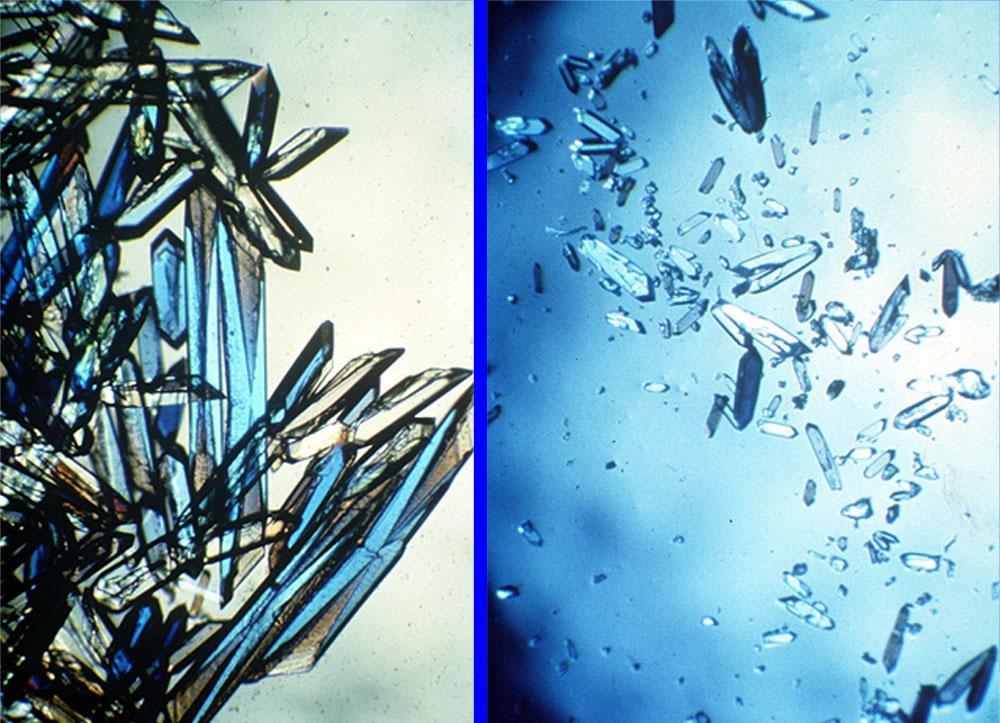Space May Be the Best Place to Grow Bone Formation Protein Crystals

Crystals of proteins that could be useful in medical research can be grown bigger and better in space than on Earth, according to the results of experiments performed on the International Space Station.
Medical research often focuses on examining how proteins work. That can include learning how to use proteins in medicines, or finding proteins that cause problems for humans and making drugs to fight them. A better understanding of a protein's 3D structure can, for example, help scientists improve how well a medicine works, or find out the best ways to kill a germ.
To decipher a protein's 3D structure, researchers often make the protein into a crystal (so it is frozen in a rigid pose) and then scan the crystals with X-rays or neutron beams. The larger and purer a protein crystal is, the better the chance that scientists can work out that protein's 3D structure. [The 6 Coolest Space Shuttle Experiments]
Most of the more than 100,000 3D protein structures that scientists have collected to date have come from X-ray scans. However, these X-ray scans cannot detect hydrogen atoms, which make up about 50 percent of the atoms in these proteins and may play important roles in the protein's activity. Neutron scans can determine the precise locations of these hydrogen atoms, but these require large protein crystals, which are difficult to grow. As such, fewer than 100 3D protein structures have been determined using neutron beams, said study lead author Joseph Ng, a biochemist and director of the Biotechnology Science and Engineering Program at the University of Alabama in Huntsville.
Previous research found that growing large pure crystals of protein is difficult on Earth because of effects arising from the planet's gravity. In gravity, heavier fluids sink and lighter fluids rise, driving convection or churning that can interfere with crystal formation. Previous work has long suggested that in the microgravity experienced in orbit around Earth, such problems with crystal growth would largely vanish, the researchers wrote in a paper describing the new experiments. (This new experiment is not the first time scientists have grown protein crystals in space. Cost and logistics are also barriers to carrying out these kinds of experiments).
The scientists behind the new study designed microgravity experiments to grow crystals of a protein known as inorganic pyrophosphatase (IPPase) in space. This protein is an enzyme found in most living organisms that plays an important role in bone formation, DNA synthesis, and the making and breaking down of fats, the researchers said.
The protein crystallization system the scientists developed for the experiments uses tiny tubes to control the flow of a solution containing dissolved proteins. The geometry of the tubes forces the proteins to concentrate in part of the solution, causing it to become supersaturated, meaning there are too many proteins to stay comfortably dissolved. The proteins then emerge from the solution to form a crystal.
Get the Space.com Newsletter
Breaking space news, the latest updates on rocket launches, skywatching events and more!
The researchers launched their system to the space station on April 18, 2014, inside a Dragon cargo spacecraft built by the private spaceflight company SpaceX. The hardware returned six months later on another Dragon cargo vehicle.
To scan protein 3D structure using neutron beams, crystals larger than 1 cubic millimeter are needed, Ng told Space.com.
"On Earth, we get crystals about 0.5 cubic millimeters large on average," he said. "In space, on average, we grow crystals at least 6 cubic millimeters large." These are the largest known IPPase crystals grown to date, the researchers said.
The space-grown crystals were not just superior in size, but also in purity, Ng said. This improved quality helped the researchers achieve at least 50 percent higher resolution with them with neutron scans, he said.
The researchers plan to grow more protein crystals in microgravity, including ones from infectious bacteria and others related to human health, Ng said. He and his colleagues have already founded a biotechnology company, iXpressGenes, to grow protein crystals in microgravity and determine their 3D structures as a commercial service.
The scientists detailed their findings July 24 at the annual meeting of the American Crystallographic Association in Denver.
Follow Charles Q. Choi on Twitter @cqchoi. Follow us @Spacedotcom, Facebook and Google+. Original article on Space.com.
Join our Space Forums to keep talking space on the latest missions, night sky and more! And if you have a news tip, correction or comment, let us know at: community@space.com.

Charles Q. Choi is a contributing writer for Space.com and Live Science. He covers all things human origins and astronomy as well as physics, animals and general science topics. Charles has a Master of Arts degree from the University of Missouri-Columbia, School of Journalism and a Bachelor of Arts degree from the University of South Florida. Charles has visited every continent on Earth, drinking rancid yak butter tea in Lhasa, snorkeling with sea lions in the Galapagos and even climbing an iceberg in Antarctica. Visit him at http://www.sciwriter.us









